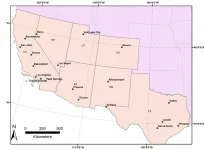The USA's inability to control its own epidemic is in stark contrast to its role as the largest global funder of HIV research and AIDS programs worldwide.
In a new six-paper Series published today in The Lancet, authors highlight the ongoing challenges to ending the HIV epidemic in the USA, including racial, sexual, and gender disparities; significant gaps in domestic program funding; and a lack of access to HIV treatment and prevention services due to geography and a patchwork health care system.
The USA failed to meet the ambitious 2020 targets set by the Obama administration's National AIDS Strategy in 2010 [1], and public health efforts have been drastically slowed due to the COVID-19 pandemic, especially for women and minorities. The authors call for significant and sustained public health actions, including continuing to support the Ending the HIV Epidemic (EHE) initiative, which aims to decrease the number of new HIV infections in the USA by 90% within the next 10 years [2].
"The profound racial and gender health disparities brought to light by the COVID-19 pandemic, while alarming, are sadly nothing new, as the HIV epidemic has shown us for more than 40 years," says Dr Chris Beyrer a professor of Public Health and Human Rights in the Johns Hopkins Bloomberg School of Public Health, who led the series.
He continues, "Since the early days of HIV we've seen sexual and gender minorities along with people of color bear the brunt of the epidemic. While the papers in our Series point out the significant advances we've made in developing treatment and prevention measures and highlight how the face of the epidemic has changed demographically and geographically, the one thing that sadly hasn't changed is that the people who need interventions the most are often the ones left out." [3]
Although overall HIV infections in the USA declined by 16% during the past decade, from 44,716 in 2009 to 37,428 in 2018, significant disparities in race, gender, ethnicity, and sexual minorities remain. The risk of HIV infection has increased for Black people, Hispanic people, and men who have sex with men (MSM). And these unequal risks of infection are even greater for populations living in the South and rural areas across the country.
A shifting HIV landscape
The geography of the US epidemic has shifted dramatically and is now most intense in the South, which represents 37% of the US population but 51% of people living with HIV and 47% of new HIV diagnoses in 2018.
People living with HIV in the South are more likely to live in rural areas, creating more challenges in reaching HIV care and prevention services, including pre-exposure prophylaxis (PrEP) services, than people who live in urban or periurban areas. For example, the South has the lowest number of PrEP users per new HIV diagnosis (i.e., PrEP-to-need ratio), at 1.0 compared with 1.8 nationally and more than half of MSM who live at least 60 minutes' drive from PrEP services live in the South. In addition, more than half of the 12 states that have not yet expanded Medicaid, restricting access to both general health care and HIV treatment services, are in the South (Texas, Tennessee, Mississippi, Alabama, Florida, Georgia, South Carolina, and North Carolina).
HIV-related, anti-gay stigma, and suboptimal rates of health literacy in the South also play essential roles in lower access to HIV prevention and treatment services in this area than in other areas of the country.
Disproportionate burden among Black people in the South occurs in both men and women: in 2018, 38% of all new HIV diagnoses among MSM were in the Black population, and 63% of those diagnoses occurred in the South. Similarly, 58% of new HIV diagnoses among women were in the Black population, and 65% of those diagnoses occurred in the South.
"What first started as an epidemic concentrated in large, coastal cities has transformed--becoming increasingly Southern and increasingly rural. As the geography shifts so do other demographics, which accounts for the rise in infections among people of color and other sexual and gender minorities," says series author Dr Patrick Sullivan, a professor of epidemiology in Emory University's Rollins School of Public Health. "It's incredibly important to understand where the epidemic is surging and why so that we can reach these populations with essential HIV services to help keep them healthy and virally suppressed and prevent them from spreading HIV to others." [3]
When race, gender, and place intersect
Geographic disparities are driven by race and ethnicity, with a higher burden of HIV infection among Black people than among individuals of other races or ethnicities. Black people, who represent 13% of the US population have accounted for 41% of the 700,000 total AIDS-related deaths in the USA since the epidemic began. In 2018, Black people accounted for 43% of HIV diagnoses, while Hispanic or Latinx people accounted for 26% of diagnoses (and 18% of the population) and white people for 26% of diagnoses (and 77% of the population).
The Black-white disparity is even more pronounced among women. Although new diagnoses of HIV infections have decreased among women in the USA overall, in 2018 Black women accounted for 58% of HIV diagnoses among women despite being 14% of the US female population.
Women living with HIV include women of reproductive age, older women, and transgender women, who all require unique health interventions, including access to reproductive health services, and access to care for chronic co-morbidities, including obesity, cardiovascular disease, and neurocognitive impairment
Transwomen, especially transwomen of color, report some of the highest HIV burdens, with HIV prevalence substantially higher among transwomen (14%) than among cis women (less than 1%) in the USA. However, many transwomen are unaware of their infection and more than half (51.4%) of seropositive Black transwomen in a study in six US cities had not been diagnosed.
"Women living with HIV are often left out of research and clinical trials, making it that much more challenging to reach them with care and treatment innovations," says series author Dr Adaora Adimora, a professor of Medicine and Epidemiology at the University of North Carolina at Chapel Hill. "We need robust public health reforms to ensure that women not only have access to HIV services but can also access additional crucial support systems such as safe housing, resources to prevent gender-based violence, and the elimination of structural and system racism." [3]
Race, place, and ethnicity also play a key role in new infections among MSM. In 2018, 38% of all new HIV diagnoses among MSM were in the Black MSM population, and 63% of those diagnoses occurred in the South. Although HIV diagnoses among MSM were stable from 2009 to 2018, that stability belies underlying inequities: during that decade, diagnoses among non-Hispanic white MSM decreased by 25%, remained stable among Black MSM, and increased by 20% among Hispanic MSM.
"While MSM have been the face of the AIDS epidemic since the 1980s, the demographics are clearly shifting and as MSM living with HIV are more likely to be Black or Hispanic and live outside of urban centers, and we must find culturally appropriate and nuanced solutions that will reach these populations, no matter where they live," says series author Dr Kenneth Mayer, Medical Research Director of Fenway Health and a professor at Harvard Medical School and Harvard TC Chan School of Public Health. [3]
Intertwined epidemics
The opioid epidemic, especially in the rural area areas such as Appalachia, has become intertwined with the HIV epidemic among people who inject drugs (PWID) and has been associated with large transmission clusters, many in counties with historically low HIV prevalence from sexual contact.
In serial surveys of PWID in 22 metropolitan cities from 2005-15, the racial composition of new PWID changed; the percentage of new Black PWID decreased from 38% to 19%, while new white PWID increased from 38% to 54%. These findings were echoed both in new HIV diagnoses during 2010-16 when HIV diagnoses decreased by 52% among Black PWID and 30% among Hispanic PWID. By 2015, new HIV diagnoses in PWID shifted to people who were predominantly white, were younger than 35 years of age, and who resided in non-urban settings.
Rural communities are especially vulnerable to the opioid and HIV co- epidemics due to reduced access to health care, fewer providers to treat opioid use disorder and HIV, very few harm-reduction programs such as syringe exchanges, overdose education, naloxone distribution, and addiction treatment programs.
Gender differences in PWID are common. Women who inject drugs are 1.2 times more likely to acquire HIV than their male counterparts, often being second to use the needle after their male injection partner. In 2017, women accounted for 28% of new HIV diagnoses among PWID.
"We won't be able to end the co-epidemic of HIV and opioids until we reduce the stigma associated with both substance abuse and HIV, especially in rural areas that are poorly equipped to deal with these issues in the first place," says series author Dr Sally Hodder, rofessor of Medicine and director, West Virginia Clinical and Translational Science Institute, West Virginia University. "In places such as West Virginia, where the collapse of the coal mining industry and extreme poverty have exacerbated the opioid epidemic, this includes decriminalizing substance abuse, providing clean, safe places for syringe exchanges and other interventions, and offering comprehensive HIV prevention, care, and treatment services." [3]
From patchwork coverage to progress
People living with and at risk for HIV seek health services via a patchwork network of payers, providers, and financing mechanisms. People living with HIV are primarily covered by Medicaid (40%), followed by private insurance (35%), with smaller shares covered by Medicare (8%) and other sources (7%), and with 11% uninsured. Many also get care through other programs, particularly the Ryan White HIV/AIDS Program, which serves as the nation's safety net for people with HIV who remain uninsured or underinsured but offers modest or no support for prevention services.
While uninsurance has drastically declined over the past decade thanks to the Affordable Care Act (ACA), the USA trails other high-income countries in key HIV-specific metrics, including rates of viral suppression [4]. And the system remains complex with coverage opportunities varying substantially across the country, leaving many people outside the system.
"Despite the ACA's major expansions, coverage remains uneven across the country, leaving some people with and at risk for HIV outside the system, particularly in the South," says series author Jennifer Kates, Senior Vice President of Global Health and HIV Policy at the Kaiser Family Foundation. "The Obama and Trump administrations developed key targets to curb the epidemic, but the fractured nature of the US health system could make it hard to reach them, particularly for the most vulnerable." [3]
Series authors conclude that ending the HIV epidemic in the USA will require a unified, national approach that includes universal access to healthcare; reduces geographical, racial, and ethnic disparities in HIV services; and addresses discrimination and racism in health care.
"The USA has shown tremendous leadership in fighting the AIDS epidemic on a global scale, now we must also show that same leadership here at home. We have the innovations and expertise to make it possible, we just need the political will to do it," Beyrer says.
Writing in a linked comment, Dr Errol Fields of the Johns Hopkins University School of Medicine notes, "Policy, public health, clinician, and community stakeholders must prioritise strategies that attend to the social inequities at the intersection of race, gender, class, age, and sexuality that compound the impacts of HIV and COVID-19 in Black communities. The racial disparities that so rapidly emerged with COVID-19 are a reminder that until these inequities are addressed, disparities in HIV and COVID-19 outcomes will persist and ending the HIV epidemic will remain elusive."
INFORMATION:
NOTES TO EDITORS
Support for the Lancet Series on HIV in the USA was provided in part by the Foundation for AIDS Research (amfAR), the National Institute on Drug Abuse (NIDA), the Johns Hopkins Center for AIDS Research (P30AI094189), and the Desmond M Tutu Professorship in Public Health and Human Rights at Johns Hopkins University. A full list of researchers involved in the study, and their affiliations, can be found in the Article.
The labels have been added to this press release as part of a project run by the Academy of Medical Sciences seeking to improve the communication of evidence. For more information, please see: http://www.sciencemediacentre.org/wp-content/uploads/2018/01/AMS-press-release-labelling-system-GUIDANCE.pdf if you have any questions or feedback, please contact The Lancet press office pressoffice@lancet.com
[1] FACT SHEET: The National HIV/AIDS Strategy: Updated to 2020: https://obamawhitehouse.archives.gov/the-press-office/2015/07/30/fact-sheet-national-hivaids-strategy-updated-2020
[2] https://www.hiv.gov/federal-response/ending-the-hiv-epidemic/overview
[3]Quote direct from author and cannot be found in the text of the Article.
[4] Kaiser Family Foundation: https://www.kff.org/hivaids/slide/hiv-viral-suppression-rate-in-u-s-lowest-among-comparable-high-income-countries/
Peer-reviewed / Review and modelling / People



